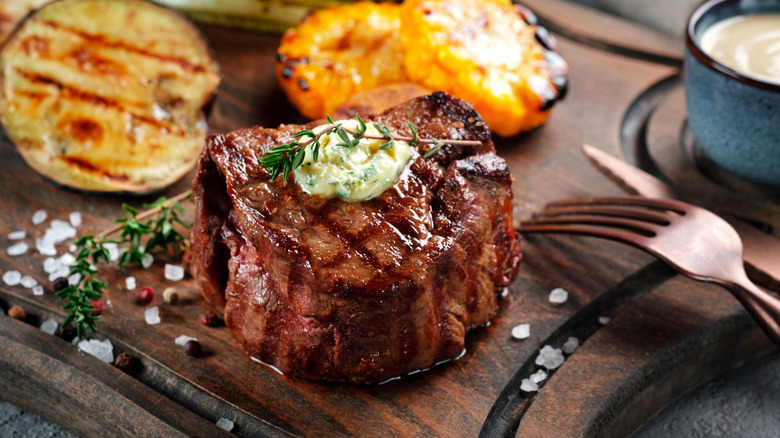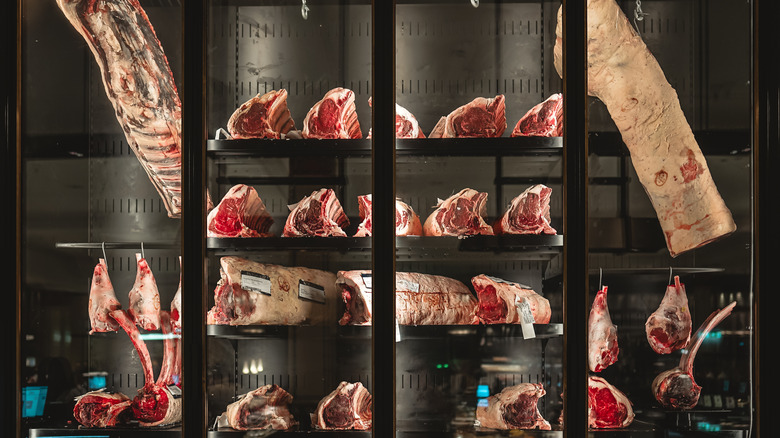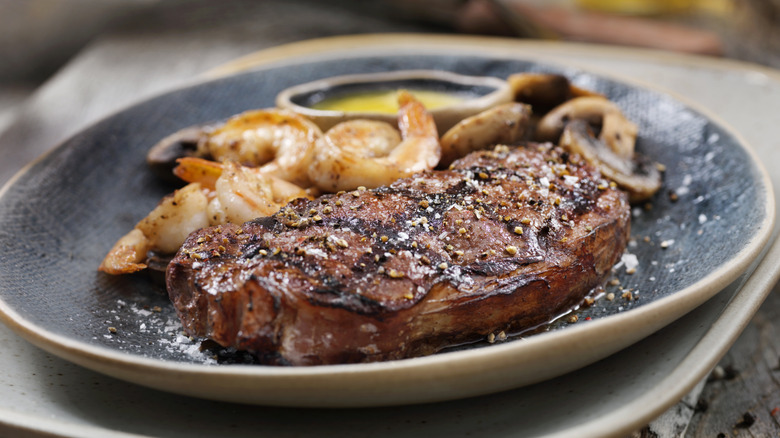The Reason Why Grocery Store Steaks Are Almost Never Dry Aged
If you have nothing better to do, go down to your local grocery store and pick up a steak. It doesn't have to be anything expensive, it could be any cut of steak, just so long as it's a 100% real, unprocessed piece of meat. Take note of the texture — chances are you can describe the raw steak as feeling cold, moist, and squishy through the plastic wrapper. It's certainly not dry whatever that may mean. Now, you can go home and reward yourself with a nice steak dinner. But why did we mention your steak not being "dry?" Shouldn't all steaks be moist and juicy, instead of dry and tough?
A dry-aged steak doesn't mean your steak is being dried out until it gets the texture of beef jerky. Instead, dry aging refers to a very specific method of aging and tenderizing the beef. A prime example of dry aging involves taking a cut of beef and storing it in a temperature-controlled environment. As the steaks "age" over the course of time, natural chemical changes occur in the meat, such as the enzymes breaking down to give a more tender surface, or bacterial changes resulting in a much more complex flavor. If you've ever seen the stereotypical depiction of a butcher shop freezer with meat hanging from hooks, that's an example of dry aging.
But what does dry aging have to do with the steak you get at your supermarket? And why does your grocery store avoid serving dry-aged steak?
Wet aging is cheaper than dry aging
If you can get dry-aged steak, wouldn't that imply that there exists such a thing as wet-aged steak? There do indeed exist wet-aged steaks, and it's most likely the kind of steak you pick up at your local supermarket. What separates the dry-aging process from the wet-aging process?
Wet aging, unlike dry aging, is a method in which meat is vacuum-sealed in a plastic bag rather than left out on hooks. The meat is cut, portioned, and then sealed into a bag where it is stored at a very low temperature. During the course of around ten days, enzymes start to break down the meat, resulting in changes to flavor and texture just as the dry-aging process does. This change in flavor and texture, however, isn't as prominent in wet-aged steaks as it is in dry-aged steaks.
The reason most supermarkets use wet-aged steaks more often than not is that it's both a faster and cheaper method of aging steaks. While it may take a few weeks to a few months for a steak to dry age to perfection, it only takes about a week and a half for a steak to get perfectly wet-aged. Why waste all that time and money when you can get a steak that's equally as good for half the time and cost? It's not to say that wet-aged steaks are bad, to be sure, but they're the cheaper, cost-efficient version of a dry-aged steak.
You can find dry-aged steaks at a steakhouse
It goes without saying that the steak you get at a steakhouse tastes just a little different than the steak you get at the supermarket. While there are many different factors to be considered, such as the quality of the steak, the recipe used, and who prepared it, one important reason why your steakhouse dinner tastes better than your steak dinner at home is that the steakhouse dry ages its steaks.
Because of the time and resources needed to dry age a steak, it would only make sense that a steakhouse — in particular, a rather high-end steakhouse — would be able to use dry-aged steaks more than your average supermarket. In fact, many steakhouse restaurants not only order dry-aged steaks from elsewhere, but they also have the option of making their own dry-aged steaks. Dry-aging chambers do exist, resembling a cross between a meat display and a sophisticated climate-controlled temperature box. Customers can see the dry-aging process first-hand while also seeing how the restaurant prepares its meat without any smoke or mirrors attached. After all, if customers can see just how their delicious steak is prepared, they'll be more inclined to return to the restaurant.
Of course, some steakhouses also use wet-aged steaks too. Wet-aged steaks not only provide a delicious texture and flavor, but they also benefit from being cheaper, moister, and much easier to get than the premium dry-aged stuff.


